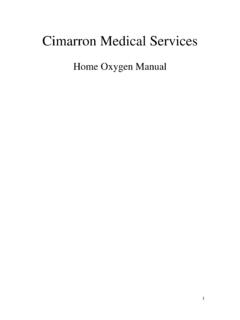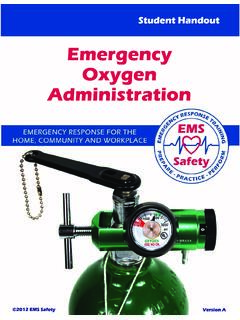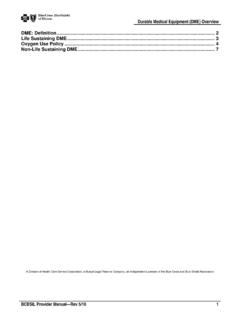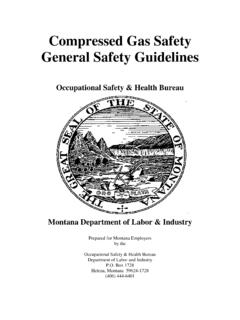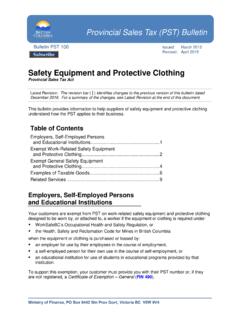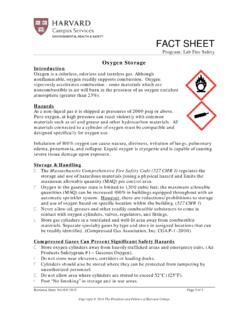Transcription of Diver’s breathing gas standard and the frequency of ...
1 Health and Safety Executive Health and Safety ExecutiveIntroduction This diving information sheet (DVIS) is part of a series of information sheets providing guidance on diving at work. It identifies the correct standard to be used for assessing the quality of divers breathing gas taking into account the 2014 version of BS EN 12021. It details the requirements for breathing gas composition and also provides guidance on the frequency of tests. Unit symbols and measurementThroughout this DVIS extracts from EH40/2005 Workplace Exposure Limits1 and BS EN 12021:2014 Respiratory equipment Compressed gases for breathing apparatus 2 are shown as ml m-3, mg m-3 and ppm (parts per million by volume).
2 Legislation The Control of Substances Hazardous to Health Regulations 2002 (as amended) (COSHH)3 and the associated Approved Code of Practice (ACOP) and guidance4 apply. standard for divers breathing gases BS EN 12021:20142 supersedes the previous 1998 version of the standard and is the appropriate standard for compressed breathing gases used by divers. The 2014 version of the standard provides details of the composition of breathing air, as well as the following breathing gases:n oxygen compatible air;n nitrogen depleted air;n oxygen enriched air;n breathing oxygen ;n oxygen and nitrogen gas mixtures;n oxygen and helium gas mixtures;n oxygen , helium and nitrogen gas mixtures.
3 Standards for divers breathing airThe standards for breathing air in BS EN 12021:20142 are detailed in Table A: Table A Composition of breathing airComponentConcentration at atmospheric pressureOxygenIn the range of (21 +/- 1) %Carbon dioxideLess than or equal to 500 ml m-3 (500 ppm by volume)Carbon monoxideLess than or equal to 5 ml m-3 (5 ppm by volume)OilLess than or equal to mg m-3 (Droplets or mist)Odour/tasteNo significant odour or tasteLiquid waterNone presentWater contentThere should not be any free liquid water content in the breathing gas. The breathing gas must have a dew point sufficiently low to prevent condensation and freezing. The dew point is the temperature where water vapour condenses into liquid water 3.
4 The allowable water content of diver s breathing air is shown below in Tables B and C:Diving Information Sheet No 9 (rev2)Diver s breathing gas standard and the frequency of examination and testsHSE information sheet1 of 5 pagesTable B Water vapour content of high pressure breathing airNominal maximum supply pressureMaximum water content of air at atmospheric pressure40 to 200 barLess than or equal to 50 mg m-3 Greater than 200 barLess than or equal to 35 mg m-3 Compressors used for charging high pressure cylinders greater than 200 barLess than or equal to 25 mg m-3 Water vapour content for breathing air supplied at pressure up to 40 bar The maximum water content of air supplied at 40 bar and below.
5 Ie low pressure air compressor supplies for surface supplied diving equipment and compression chambers is provided in Table C below: Table C Water vapour content for breathing air up to 40 barNominal maximum supply pressure (bar)Maximum water content of air at atmospheric pressure and 20 C mg m-3529010160151102080256530554050 Other methods of establishing the maximum permitted water content have been developed. The details are outside the scope of this DVIS, but can be obtained from HSE Research Report 427 Moisture levels in compressed breathing air6. Standards for divers breathing gas oxygen and nitrogen gas mixtures (nitrox)The standards for breathing mixtures of oxygen and nitrogen in BS EN 12021:20142 are detailed in Table D.
6 Table D Composition of oxygen and nitrogen mixesComponentConcentration at 1013mb and 20 COxygen mixes containing <20% by volume 20% by volume(Stateda +/- )%(Stated a +/- )%)NitrogenRemainderWater 15 mg m -3 Carbon Dioxide 5 ml m -3 (ppm)Carbon Monoxide 3ml m -3 (ppm)Oil mg m-3 Total volatile non-substituted hydrocarbons (vapour or gas) as methane equivalent 30 ml m -3 Other non-toxic gases c< 1% a Percentage as stated by the supplierb Tolerance value is a percentage of the total gas mixturec These gases include argon and all other noble gasesTable D is applicable to oxygen and nitrogen mixtures provided by industrial gas suppliers. Nitrox mixtures may also be generated by diving contractors themselves using membrane systems, decanting/gas booster systems, or other methods to produce nitrogen depleted air and oxygen enriched air.
7 Health and Safety Executive2 of 5 pagesStandards for divers breathing gas oxygen and helium gas mixtures (heliox)The standards for breathing mixtures of oxygen and helium in BS EN 12021:20142 are detailed in Table E:Table E Composition of oxygen and helium mixesComponentConcentration at 1013mb and 20 COxygen mixes containing 10% by volume10% to 20% by volume 20% by volume(Stated a +/- b)%(Stated a +/- b)%(Stated a +/- b)%HeliumRemainderWater 15 mg m-3 Carbon Dioxide 5 ml m-3 (ppm)Carbon Monoxide ml m-3 (ppm)Oil mg m-3 Total volatile non-substituted hydrocarbons (vapour or gas) as methane equivalent 30 ml m-3 (ppm)Hydrogen 10 ml m-3 (ppm)Other non-toxic gases c< a Percentage as stated by the supplierb Tolerance value is a percentage of the total gas mixturec These gases include argon and all other noble gasesNitrogen, water and carbon dioxide content applicable to diver gas recovery (reclaim) system compressor samplesThe standards for breathing mixtures of oxygen and helium in Table E above are fully applicable to the heliox mixtures provided for saturation diving operations by industrial diving gas suppliers.
8 It is recognised that heliox mixtures found within diver gas recovery (reclaim) systems may have higher levels of moisture, nitrogen and carbon dioxide content than the maximum levels specified in Table E. NitrogenIn common with most gases, the physiological effects of nitrogen are related to its partial pressure at the depth it is being inhaled. A maximum of 5% nitrogen content in reclaim gases for depths up to 350 m would be acceptable. Water contentThere is a risk that increased moisture levels may lead to increased corrosion rates inside pressure vessels and pressurised pipework. Where pressure vessels and pressurised pipework are likely to contain higher levels of moisture than the maximum levels specified in Table E (eg inside reclaim systems), it is important for diving contractors to have arrangements in place to ensure that suitable examination, testing and certification of all such plant and equipment is periodically undertaken at an appropriate frequency .
9 The increased moisture content within reclaim system gas is unlikely to cause internal freezing of regulators and valves etc when gas expands through the system. This is because reclaim systems are not high pressure systems and, in addition, the Joule-Thompson effect means that heliox does not cool on expansion. Nevertheless, the provision of heated gas supplies should also be considered when diving is carried out in cold waters. Divers breathing gas will require active heating for dives deeper than 150 meters. When operating using breathing gas supplied from a gas recovery (reclaim) system the maximum water vapour content of diver s breathing gas is shown in Table F Water vapour content for reclaim system breathing gas up to 40 barNominal maximum supply pressure (bar)Maximum water content of reclaim system gas at atmospheric pressure and 20 C mg m-3104101528020200251753014540110 Note: Reclaim gas based on dewpoint of 0 C3 of 5 pagesCarbon dioxideThe source for diver reclaim make-up gas should comply with the requirements of BS EN 12021:2014 for carbon dioxide levels.
10 The circulating gas supply within the reclaim system should be operated to minimise the carbon dioxide levels. Carbon dioxide levels within the circulating gas of diver reclaim systems should normally be limited to a maximum partial pressure of 5 mbar at the depth of the diver (ie 5000 ml m-3 (ppm) when the diver is on the surface, corresponding to SEV (surface equivalent value)). With the exceptions of nitrogen, water vapour and carbon dioxide the standards for breathing mixtures of oxygen and helium in Table E should be applied to saturation diving diver reclaim systems. Other contaminants A risk assessment should be carried out to establish if any other contaminants should be tested for in addition to those specified in BS EN 12021 lubricant safety data sheet and/or the compressor manufacturer s operation and maintenance manuals should be checked to see if there are any specific substances that should be tested for.










